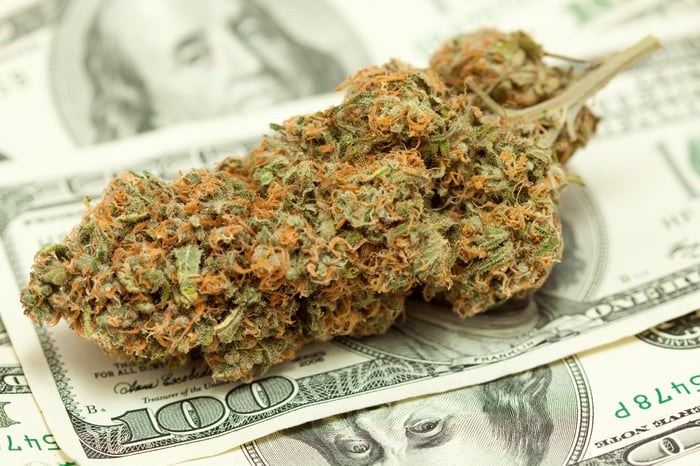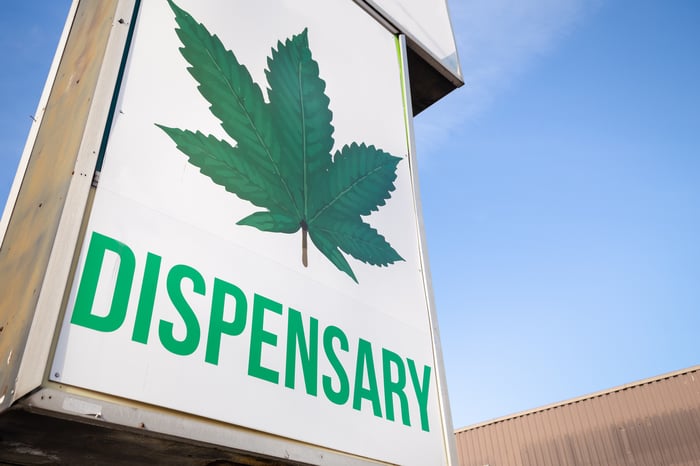Perhaps it's no coincidence that marijuana is green. In the years to come, cannabis could be one of the fastest-growing industries on the planet. According to cannabis analytics company New Frontier Data, U.S. weed sales could catapult from $13.2 billion in 2019 to more than $41 billion by 2025. For those of you keeping score at home, this works out to a compound annual growth rate of 21%.
But if there's one thing marijuana stock investors have learned over the past couple of years, it's that no two pot stocks are alike. While at least half of all pot stocks currently trade at a valuation higher than analysts' consensus price target, the following five marijuana stocks offer upside ranging between 49% and 83%, according to Wall Street.

Image source: Getty Images.
Jushi Holdings: Implied upside of 83%
The biggest bargain in the cannabis space right now, based on price targets, is U.S. multistate operator (MSO) Jushi Holdings (JUSHF 2.26%). Wall Street's consensus price target of $7.63 suggests it has as much as 83% upside.
Jushi is a unique MSO because of its focus on limited license states. A large portion of the company's sales in 2021 will stem from Pennsylvania, Virginia, and Illinois, all of which restrict the number of licenses they issue either in total or within defined territories. This strategy will allow Jushi to pick up significant market share without having to worry too much about competition. It's a great way to effectively build up its brand without breaking the bank on marketing costs.
My top marijuana stock to buy for December is also noteworthy for its management team putting their money where their mouth is. Of the roughly $250 million in capital raised since inception, insiders and executives have put up about $45 million.

Image source: Getty Images.
Harvest Health & Recreation: Implied upside of 66%
On the theme of U.S. MSOs: Harvest Health & Recreation (HRVSF) also offers plenty of upside, per Wall Street.
This big catalyst here is the now-complete 2020 election. The passage of Proposition 207 will legalize recreational marijuana in Arizona, Harvest's Health's home market, and the state where it leads in market share. Arizona has a good chance to reach $1 billion in annual weed sales by mid-decade, putting Harvest Health in good shape to succeed in the Grand Canyon State.
Also positive is Harvest Health's cost-cutting efforts. Like many North American cannabis companies, management got a bit overzealous on the acquisition front in 2019. After terminating a small number of deals and reining in unnecessary expenses, Harvest Health might be on track to eke out a small profit in 2021.

Image source: GW Pharmaceuticals.
GW Pharmaceuticals: Implied upside of 57%
Though its management team hates being lumped in with "pot stocks," cannabinoid-focused drug developer GW Pharmaceuticals (GWPH) has plenty of implied upside.
It's no secret that GW Pharmaceuticals' primary growth driver is Epidiolex. In the quarter that ended in September, Epidiolex accounted for $132.6 million of the company's $137.1 million in total sales. In less than two years, the company has grown Epidiolex -- which is approved to treat two rare forms of childhood-onset epilepsy, as well as tuberous sclerosis complex (a more recent label expansion) -- into a treatment with over $500 million in annual run-rate revenue. It's possible that GW Pharmaceuticals will turn the corner to recurring profitability in 2021.
Wall Street also seems excited about GW Pharmaceuticals' pipeline and label expansion opportunities. In the fourth quarter of 2020 and first quarter of 2021, GW will be starting phase 3 multiple sclerosis spasticity trials in the U.S. for Nabiximols, as well as a clinical study for spinal cord injury spasticity.

Image source: Getty Images.
Columbia Care: Implied upside of 51%
Another MSO with significant upside potential, according to Wall Street, is Columbia Care (CCHWF -0.85%).
For years, Columbia Care was primarily known for its medical cannabis dispensaries and manufacturing facilities. However, a rash of adult-use weed legalizations across the country has it now pivoting to the recreational market. Columbia Care's more than six dozen operational dispensaries can be found in California, Arizona, New Jersey, Colorado, Florida, and Illinois, to name a few of its potential billion-dollar markets.
A big key to Columbia Care's success is going to be integrating its numerous acquisitions. It recently closed its purchase of The Green Solution (TGS), which is Colorado's leading vertically integrated cannabis company. At the moment, Colorado trails only California in annual weed sales.

Image source: Getty Images.
OrganiGram Holdings: Implied upside of 49%
Finally, there's the only Canadian pot stock with a market cap north of $200 million that Wall Street believes is currently undervalued: OrganiGram Holdings (OGI 3.68%).
What separates OrganiGram from its peers is the company's decision to focus on a single grow site. Whereas most Canadian licensed producers attempted to operate between three and 15 cultivation facilities, OrganiGram centered its efforts solely on the Moncton facility in New Brunswick. Having only one facility makes it a lot easier to adjust its supply chain, alter production, and reduce expenses to meet consumer demand.
OrganiGram's efficiencies are likely playing a role in its more favorable view from Wall Street analysts. For example, the Moncton facility uses a three-tiered growing system, thereby maximizing the square footage of the facility's grow rooms. OrganiGram also invested heavily in automated machinery capable of producing 4 million kilos of infused chocolates each year. These derivative products boast much higher margins than traditional dried flower.





